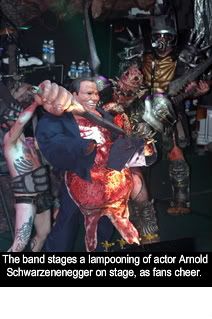
Shock, Rock, & Roll:
On a summer weeknight, hundreds of sweaty concertgoers are packed into an overcrowded venue like sardines. All the lights are down, as the crowd stands eagerly with their eyes locked firmly on the stage before them. The crowd is mostly male, with the exception of a few reluctant girls who were dragged to the show by their boyfriends. Suddenly, the image of a timer pops up on a projector screen, sporting the words “time until death,” written in eerie red letters. The audience feverishly begins to count down from sixty seconds, following the lead of the death timer. When they reach zero, the digital timer explodes on the screen, and five monstrous looking characters emerge on the stage, clad in the most outlandish masks and costumes one could ever dream of seeing. They proceed to address the audience in absurd voices that suggest failed attempts to convey a robust monster-like tone. The first cacophonous chords of one of their songs echo off the walls. None of the songs have any audible melody or comprehensible lyrics to accompany them, and yet, the crowd continues to go wild. Interestingly, only about fifty percent, at the most, of the concert consists of playing music, and the rest of the time is devoted to atrocious on-stage demonstrations and faux bodily fluids, which are splattered on the audience. All throughout the show, the audience continues to chant the name of this spectacle: “GWAR.”
Unless you are an avid heavy metal follower, then chances are, you probably have not heard of bands such as GWAR, Cradle of Filth, and Slipknot. On the other hand, you probably have heard of controversial bands and figures such as Marilyn Manson, Alice Cooper, Nine Inch Nails, and Rob Zombie, merely through mass media exposure. Why though, you may ask, are these associations significant and how do they relate to one another? Well, all of these
respective acts are part of a collective sub-genre called “shock rock” that has increasingly garnered popularity since its emergence in the late 1970s. While no “official” definition for shock rock exists, Wiktionary provides perhaps the most comprehensive description: “a genre of rock music typified by elements of theatrical shock value in live performances.” The band GWAR is perhaps one of the most extreme examples of this sub-genre. When it comes to evoking shock and repulsion from audiences, the band members of GWAR are the masters. From their frequent “lampooning” of current celebrities and political figures, which can be viewed in various web media, to their sexually charged demonstrations, GWAR attempts to combine shocking theatrics with rock music.
Since the band’s peak in the early 1990s, GWAR has received two Grammy nominations and has continued to maintain a cult-like contingency of fans that refer to themselves as the less than endearing terms of “Bohabs” and “Scumdogs.” After more than a decade long slump period, this past September, GWAR made its way back into the mainstream music world through the newly released Lust in Space. The album came in at number ninety-six on the Billboard 200, marking the band’s first mainstream chart album since 1992. Even though Lust in Space only remained on the Billboard 200 for one week, the mainstream chart recognition itself is very impressive for a band that has largely remained in the underground music scene for the past seventeen years or so. Of the band’s recent success, Greg Prato of the Allmusic database said, “When over-the-top theatrical metallists GWAR first appeared on the scene back in the late ‘80s, surely, many critics and detractors figured that the group would be a fast-fading fad. But as the years have accumulated, the group's massive cult following has only grown larger, with each successive new album and gore-tour” (Prato). Then the question arises as to how such a bizarre
and nonsensical (not to mention vulgar) act could succeed in today’s cutthroat music industry. The answer is simple: people are attracted to the strange and unnatural. Just like the revolting acts demonstrated in many of today’s most gruesome horror movies, shock rock artists like GWAR thrive on the human desire to be shocked and outraged.

No comments:
Post a Comment